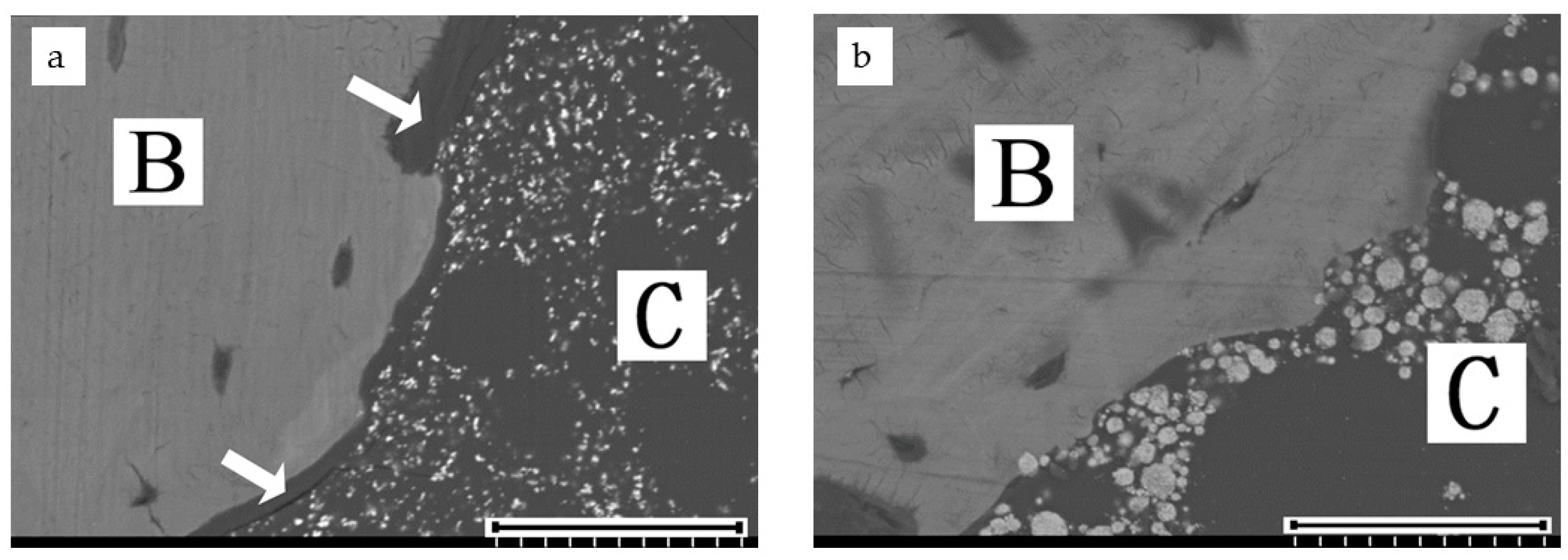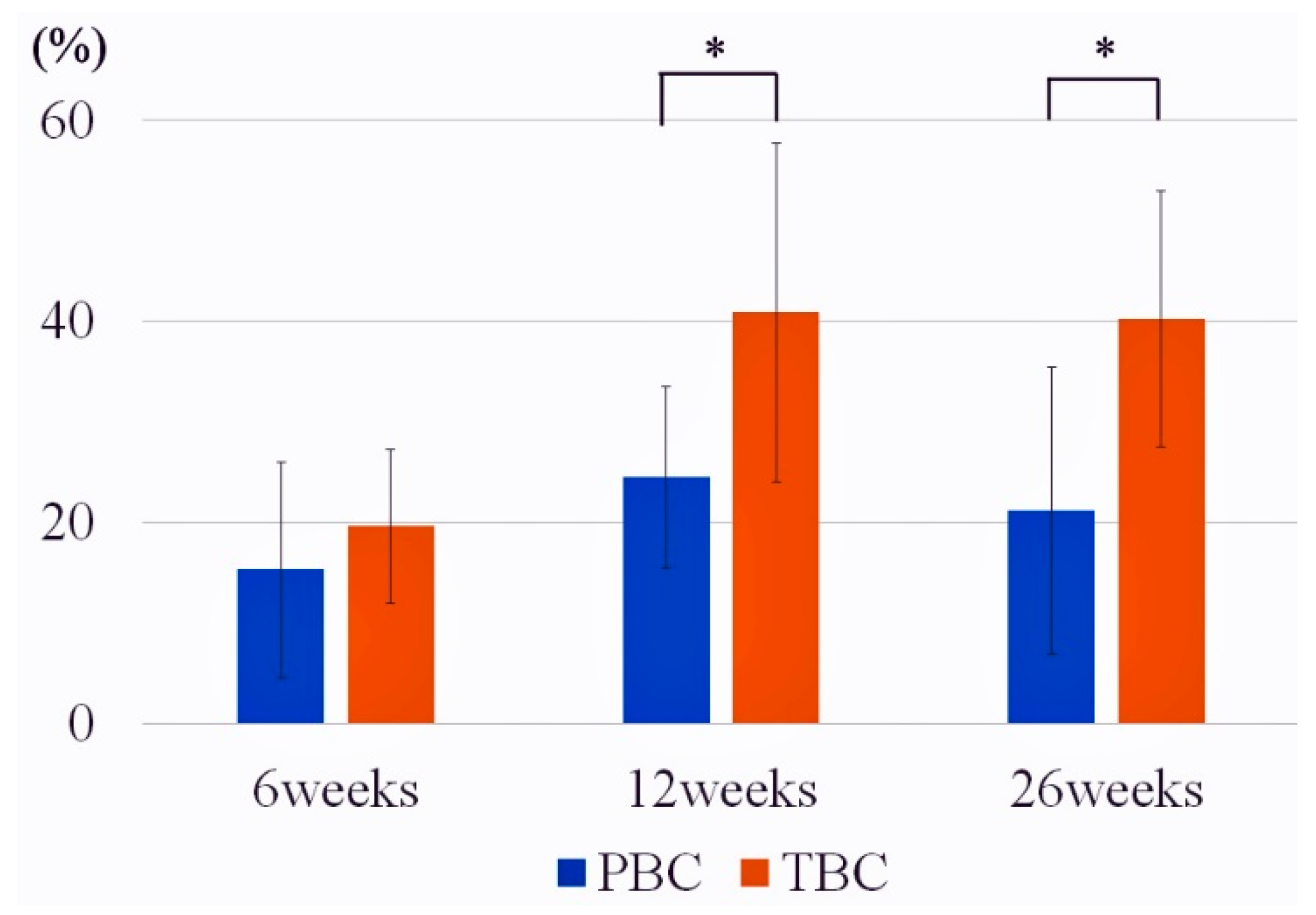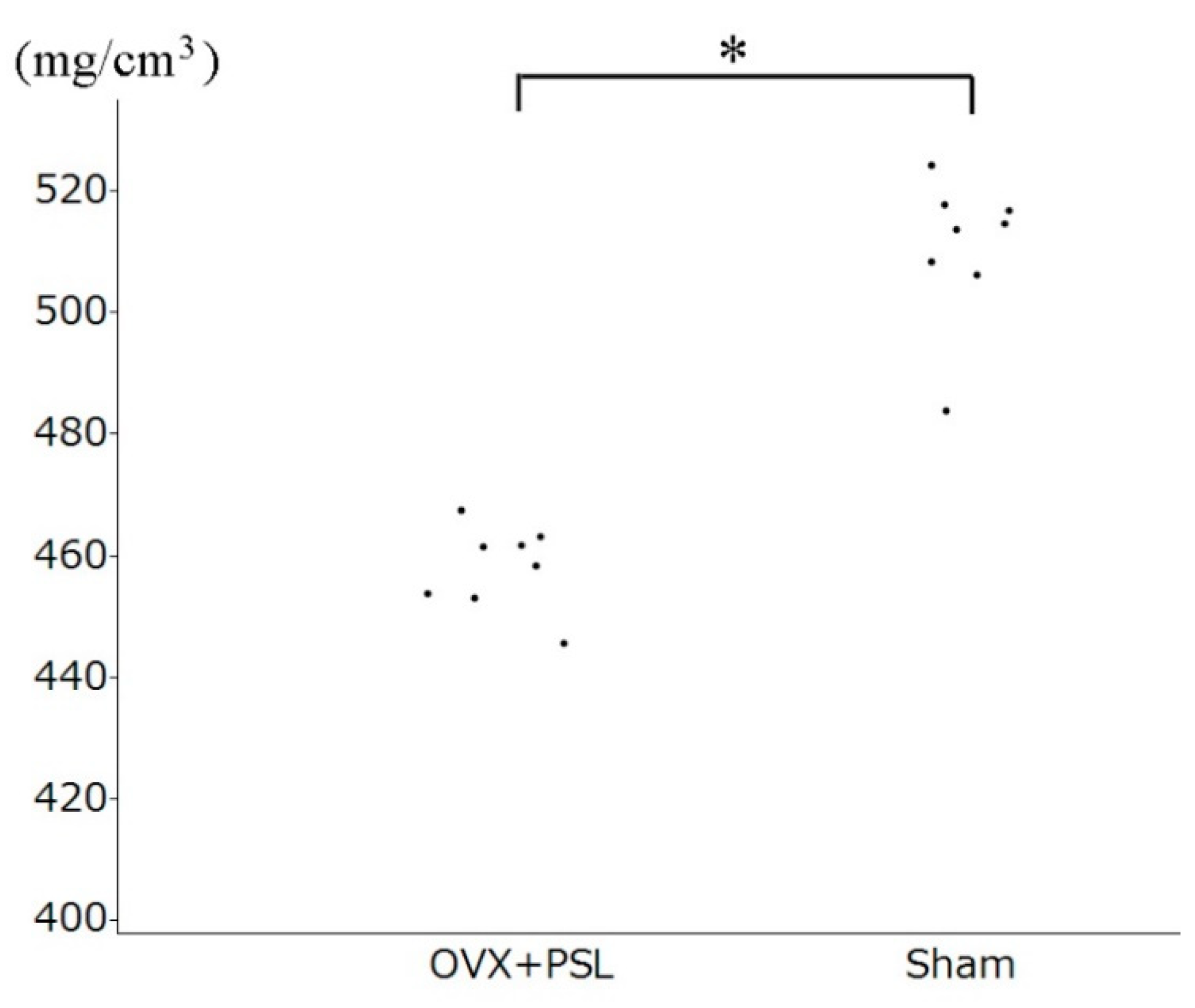Titania-Containing Bone Cement Shows Excellent Osteoconductivity in A Synovial Fluid Environment and Bone-Bonding Strength in Osteoporosis
Abstract
1. Introduction
2. Materials and Methods
2.1. Ethics
2.2. Cement Preparation
2.3. Animal Experiment—Synovial Fluid Environment Model
2.4. Animal Experiment—Osteoporosis Model
2.5. Micrographic Examination
2.6. Analysis of Osteoporosis
2.7. Push-Out Test—Osteoporosis Model
2.8. Statistical Analysis
3. Results
3.1. Surface Evaluation—Synovial Fluid Environment Model
3.2. Histological Evaluation—Synovial Fluid Environment Model
3.3. Osteoporosis Evaluation—Osteoporosis Model
3.4. Bone-Bonding Evaluation—Osteoporosis Model
4. Discussion
5. Conclusions
Author Contributions
Funding
Institutional Review Board Statement
Data Availability Statement
Conflicts of Interest
References
- Webb, J.C.; Spencer, R.F. The role of polymethylmethacrylate bone cement in modern orthopaedic surgery. J. Bone Jt. Surgry Br. 2007, 89, 851–857. [Google Scholar] [CrossRef]
- Freeman, M.A.; Bradley, G.W.; Revell, P.A. Observations upon the interface between bone and polymethylmethacrylate cement. J. Bone Jt. Surgry Br. 1982, 64, 489–493. [Google Scholar] [CrossRef]
- Maloney, W.J.; Jasty, M.; Rosenberg, A.; Harris, W.H. Bone lysis in well-fixed cemented femoral components. J. Bone Jt. Surgry Br. 1990, 72, 966–970. [Google Scholar] [CrossRef] [PubMed]
- Lewis, G. Properties of acrylic bone cement: State of the art review. J. Biomed. Mater. Res. 1997, 38, 155–182. [Google Scholar] [CrossRef]
- Breusch, S.J.; Malchau, H. What is modern cementing technique? In The Well-Cemented Total Hip Arthroplasty: Theory and Practice; Breusch, S., Malchau, H., Eds.; Springer: Heidelberg, Germany, 2005; pp. 146–149. [Google Scholar]
- Kenny, S.M.; Buggy, M. Bone cements and fillers: A review. J. Mater. Sci. Mater. Med. 2003, 14, 923–938. [Google Scholar] [CrossRef] [PubMed]
- Zhu, J.; Yang, S.; Cai, K.; Wang, S.; Qiu, Z.; Huang, J.; Jiang, G.; Wang, X.; Fang, X. Bioactive poly (methyl methacrylate) bone cement for the treatment of osteoporotic vertebral compression fractures. Theranostics 2020, 10, 6544–6560. [Google Scholar] [CrossRef] [PubMed]
- Fottner, A.; Nies, B.; Kitanovic, D.; Steinbrück, A.; Mayer-Wagner, S.; Schröder, C.; Heinemann, S.; Pohl, U.; Jansson, V. Performance of bioactive PMMA-based bone cement under load-bearing conditions: An in vivo evaluation and FE simulation. J. Mater. Sci. Mater. Med. 2016, 27, 138. [Google Scholar] [CrossRef] [PubMed]
- Liu, J.; Shirosaki, Y.; Miyazaki, T. Bioactive polymethylmethacrylate bone cement modified with combinations of phosphate group-containing monomers and calcium acetate. J. Biomater. Appl. 2015, 29, 1296–1303. [Google Scholar] [CrossRef] [PubMed]
- Fukuda, C.; Goto, K.; Imamura, M.; Nakamura, T. Bioactive bone cement with a low content of titania particles without postsilanization: Effect of filler content on osteoconductivity, mechanical properties, and handling characteristics. J. Biomed. Mater. Res. B Appl. Biomater. 2010, 95, 407–413. [Google Scholar] [CrossRef]
- Fukuda, C.; Goto, K.; Imamura, M.; Neo, M.; Nakamura, T. Bone bonding ability and handling properties of a titania- polymethylmethacrylate (PMMA) composite bioactive bone cement modified with a unique PMMA powder. Acta Biomater. 2011, 7, 3595–3600. [Google Scholar] [CrossRef] [PubMed]
- Goto, K.; Tamura, J.; Shinzato, S.; Fujibayashi, S.; Hashimoto, M.; Kawashita, M.; Kokubo, T.; Nakamura, T. Bioactive bone cements containing nano-sized titania particles for use as bone substitutes. Biomaterials 2005, 26, 6496–6505. [Google Scholar] [CrossRef] [PubMed]
- Goto, K.; Hashimoto, M.; Takadama, H.; Tamura, J.; Fujibayashi, S.; Kawanabe, K.; Kokubo, T.; Nakamura, T. Mechanical, setting, and biological properties of bone cements containing micron-sized titania particles. J. Mater. Sci. Mater. Med. 2008, 19, 1009–1016. [Google Scholar] [CrossRef]
- Imamura, M.; Goto, K.; Kawata, T.; Kataoka, M.; Fukuda, C.; Fujibayashi, S.; Matsuda, S. Titania-containing bioactive bone cement for total hip arthroplasty in dogs. J. Biomed. Mater. Res. B Appl. Biomater. 2019, 107, 1238–1245. [Google Scholar] [CrossRef] [PubMed]
- Li, P.; Kangasniemi, I.; de Groot, K.; Kokubo, T. Bonelike hydroxyapatite induction by a gel-derived titania on a titanium substrate. J. Am. Ceram. Soc. 1994, 77, 1307–1312. [Google Scholar] [CrossRef]
- Aspenberg, P.; Van Der Vis, H. Fluid pressure may cause periprosthetic osteolysis. Particles are not the only thing. Acta Orthop. Scand. 1998, 69, 1–4. [Google Scholar] [CrossRef] [PubMed]
- Sundfeldt, M.; Carlsson, L.V.; Johansson, C.B.; Thomsen, P.; Gretzer, C. Aseptic loosening, not only a question of wear: A review of different theories. Acta Orthop. 2006, 77, 177–197. [Google Scholar] [CrossRef] [PubMed]
- Cankaya, D.; Tabak, Y.; Ozturk, A.M.; Gunay, M.C. Perioperative alendronate, risedronate, calcitonin and indomethacin treatment alters femoral stem fixation and periprosthetic bone mineral density in ovariectomized rats. J. Orthop. Sci. 2015, 20, 728–733. [Google Scholar] [CrossRef]
- Ehlinger, M.; Favreau, H.; Eichler, D.; Adam, P.; Bonnomet, F. Early mechanical complications following fixation of proximal femur fractures: From prevention to treatment. Orthop. Traumatol. Surg. Res. 2020, 106, S79–S87. [Google Scholar] [CrossRef] [PubMed]
- Permuy, M.; López-Peña, M.; Muñoz, F.; González-Cantalapiedra, A. Rabbit as model for osteoporosis research. J. Bone Miner. Metab. 2019, 37, 573–583. [Google Scholar] [CrossRef]
- Baofeng, L.; Zhi, Y.; Bei, C.; Guolin, M.; Qingshui, Y.; Jian, L. Characterization of a rabbit osteoporosis model induced by ovariectomy and glucocorticoid. Acta Orthop. 2010, 81, 396–401. [Google Scholar] [CrossRef]
- Dall’Oca, C.; Maluta, T.; Cavani, F.; Morbioli, G.P.; Bernardi, P.; Sbarbati, A.; Degl’Innocenti, D.; Magnan, B. The biocompatibility of porous vs non-porous bone cements: A new methodological approach. Eur. J. Histochem. 2014, 58, 2255. [Google Scholar] [CrossRef] [PubMed]
- Fini, M.; Giavaresi, G.; Aldini, N.N.; Torricelli, P.; Botter, R.; Beruto, D.; Giardino, R. A bone substitute composed of polymethylmethacrylate and α-tricalcium phosphate: Results in terms of osteoblast function and bone tissue formation. Biomaterials 2002, 23, 4523–4531. [Google Scholar] [CrossRef]
- Shinzato, S.; Nakamura, T.; Kawanabe, K.; Kokubo, T. PMMA-based bioactive cement: Effect of CaF2 on osteoconductivity and histological change with time. J. Biomed. Mater. Res. B Appl. Biomater. 2003, 65, 262–271. [Google Scholar] [CrossRef] [PubMed]
- Li, Z.; Müller, R.; Ruffoni, D. Bone remodeling and mechanobiology around implants: Insights from small animal imaging. J. Orthop. Res. 2018, 36, 584–593. [Google Scholar] [CrossRef] [PubMed]







| Powder | TBC | PBC |
|---|---|---|
| Titania | 20 w/w | - |
| Barium sulfate | - | 6.7 w/w |
| Polystyrene/MMA copolymer | 42.5 w/w | 50 w/w |
| PMMA | 7.5 w/w | 10 w/w |
| Benzoyl peroxide | 5.4 wt% of MMA. | (a) * |
| Liquid | - | - |
| MMA | 30 w/w | 32.5 w/w |
| N,N-dimethyl-p-toluidine | 0.95 wt% of MMA. | 0.9 w/w |
| Hydroquinone | 70 ppm | 1.5 mg |
| Cement | 6 Weeks | 12 Weeks * | 26 Weeks * |
|---|---|---|---|
| TBC | 19.6 ± 7.68 | 40.9 ± 16.8 | 40.2 ± 12.7 |
| PBC | 15.3 ± 10.7 | 24.5 ± 9.02 | 21.2 ± 14.2 |
| Cement | Sham | OVX + PSL * |
|---|---|---|
| TBC | 5.08 ± 3.95 | 3.69 ± 1.89 |
| PBC ** | 3.94 ± 3.49 | 1.71 ± 1.23 |
Publisher’s Note: MDPI stays neutral with regard to jurisdictional claims in published maps and institutional affiliations. |
© 2021 by the authors. Licensee MDPI, Basel, Switzerland. This article is an open access article distributed under the terms and conditions of the Creative Commons Attribution (CC BY) license (http://creativecommons.org/licenses/by/4.0/).
Share and Cite
Kawata, T.; Goto, K.; Imamura, M.; Okuzu, Y.; Kawai, T.; Kuroda, Y.; Matsuda, S. Titania-Containing Bone Cement Shows Excellent Osteoconductivity in A Synovial Fluid Environment and Bone-Bonding Strength in Osteoporosis. Materials 2021, 14, 1110. https://doi.org/10.3390/ma14051110
Kawata T, Goto K, Imamura M, Okuzu Y, Kawai T, Kuroda Y, Matsuda S. Titania-Containing Bone Cement Shows Excellent Osteoconductivity in A Synovial Fluid Environment and Bone-Bonding Strength in Osteoporosis. Materials. 2021; 14(5):1110. https://doi.org/10.3390/ma14051110
Chicago/Turabian StyleKawata, Tomotoshi, Koji Goto, Masashi Imamura, Yaichiro Okuzu, Toshiyuki Kawai, Yutaka Kuroda, and Shuichi Matsuda. 2021. "Titania-Containing Bone Cement Shows Excellent Osteoconductivity in A Synovial Fluid Environment and Bone-Bonding Strength in Osteoporosis" Materials 14, no. 5: 1110. https://doi.org/10.3390/ma14051110
APA StyleKawata, T., Goto, K., Imamura, M., Okuzu, Y., Kawai, T., Kuroda, Y., & Matsuda, S. (2021). Titania-Containing Bone Cement Shows Excellent Osteoconductivity in A Synovial Fluid Environment and Bone-Bonding Strength in Osteoporosis. Materials, 14(5), 1110. https://doi.org/10.3390/ma14051110







